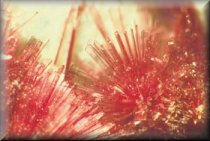On this page
About cobalt
Cobalt in South Australia
About cobalt
- Discovered in 1735 by the Swedish chemist George Brandt
- A silvery white magnetic metal of low strength and ductility at normal temperatures but ductile at high temperatures
- Occurs naturally as:
- cobalt arsenide Co(As2), known as smaltite or speiss cobalt
- cobalt sulfarsenide (CoAsS), known as cobaltite or cobalt glance
- hydrated arsenate (Co(AsO4)2.8H2O), known as erythrite or cobalt bloom
- Mainly used for making alloys, particularly thermally resistant super alloys for industry and aircraft gas turbine engines. Other alloys include:
- cobalt steel for making permanent magnets
- carboloy (tungsten carbide) and stellite (chromium–cobalt), both of which are extremely hard and used for drilling, cutting and machining steel.
- Also used in the production of rechargable batteries
Annual world production in 2013 was 120,000 tonne cobalt metal product. China continues to be the world's largest producer, mainly from cobalt-rich ore imported from the Congo (Kinshasa). Australia ranks 9th in world production at 3,900 tonne cobalt. World terrestrial resources of cobalt are 25 million tonne, with the vast majority of the resource in sediment-hosted stratiform copper deposits in Congo and Zambia.
In Australia resources of 1 Mtonne of cobalt metal occur mainly in lateritic nickel deposits, also magnetic Ni-Cu sulfide deposits in mafic and ultramafic rock.
Cobalt in South Australia
Cobalt resources in South Australia are indicated on Selected South Australian Resources map (PDF 5.9 MB), current July 2018.
Musgrave Province
The lateritic nickel-(cobalt-iron) deposit of Claude Hills in the far north-west of the South Australia has a 2011 published resource of 33.3 Mtonne at 0.07% Co for 23,310 tonne contained cobalt (also 0.8% Ni, 395 Fe).
The world class Wingellina lateritic nickel-cobalt-iron deposit a few kilometres to the west in Western Australia has a resource of 187 Mtonne at 0.08% Co for 14,960 tonne cobalt (also 1% Ni, 47% Fe).
Gawler Craton and Stuart Shelf
South Australia’s total recorded production of cobalt is ~2900 t as a by-product from the Mount Gunson Copper Mine. Between 1974 and 1986, the mine produced 290 000 t of mixed sulfide concentrate containing approximately 44.8% Cu, 10.6% Zn, 2.6% Pb, 1% Co, 0.15% Bi, 0.08% Ni and 214 g/t Ag from 7.5 Mt of ore. Production was from the Cattlegrid deposit, with cobalt occurring as carrollite (Cu(CoNi)2S4).
Mineralisation is principally in the upper surface of a paleo-permafrost brecciated sandstone of the pre-Adelaidean Pandurra Formation, which is unconformably overlain by Adelaidean Whyalla Sandstone.
Other resources in the area include an indicated resource of 19 Mtonne at 0.05% Co for 9,500 tonne cobalt metal at Windabout prospect (2000 estimate), and 1.62 Mtonne at 0.04% Co for 648 tonne cobalt metal (2012) MG 14 prospect (2012 estimate).
Other occurrences include Olympic Dam where carrollite is a minor mineral in the Cu–U–Au–Ag ore, and Wallaroo copper mines at Kadina where cobaltite was found associated with chalcopyrite.
Curnamona Province
The Mutooroo copper-(cobalt-iron-sulfur) vein deposit was worked for copper from 1887 to 1953 for production of 242 tonne copper metal. Exploration in 2007 identified cobalt, with a resource identified in 2010 of 13.1 Mtonne at 0.14% Co for 17,500 tonne contained cobalt metal (also 0.23 g/t Au, 1.48% Cu and 20% S).
The Ethiudna Mine was worked for copper–cobalt–nickel mineralisation from 1889 to 1908 and reopened for a short period in 1914 when it was renamed the New Year Gift. Ore was produced from several shafts, but there are no production records. The ore was not amenable to treatment in local smelters and 8 t of hand-picked ore were shipped to England in 1900.
Mineralisation is hosted by Paleoproterozoic Willyama Supergroup calc-silicates comprising tremolite–diopside–garnet skarn rocks. Ore minerals include chalcopyrite, cobaltite, smaltite, pentlandite, galena, sphalerite, pyrite, pyrrhotite, arsenopyrite, scheelite and molybdenite.
The nearby Ethiudna East Cobalt Deposit was discovered in 1953 with cobaltite, smaltite and erythrite hosted by siliceous tremolite marble. Associated minerals include chalcopyrite, bornite, chalcocite, pentlandite and scheelite.
The Mount Howden Cobalt Mine was worked intermittently for cobalt–nickel between 1880 and 1914. There are no production records but several tonnes of hand-dressed ore were consigned overseas.

Erythrite from Dome Rock copper mine, Curnamona Province
Mineralisation is hosted by Palaeoproterozoic Willyama Supergroup marble; ore minerals include erythrite, smaltite, cobaltite, galena, chalcopyrite and cobaltiferous pyrite.
Minor occurrences of erythrite and cobaltiferous pyrite are associated with the Dome Rock copper mine.
The Gunsight prospect in the Mount Painter Inlier comprises copper–uranium–cobalt–rare earth mineralisation hosted by Mesoproterozoic sulfide-rich schist and iron formation associated with calcsilicate and volcanics. Minerals include chalcopyrite, pyrite, uraninite, monazite, allanite and a wide range of cobaltian sulfides.
Flinders Ranges
Youngs Cobalt Mine was worked in ~1890, but production was not recorded. Nodules of erythrite are associated with copper, nickel and silver mineralisation hosted by Adelaidean diapiric breccia of the Blinman Diapir.
Other occurrences include Nichols Nob, Mount Ogilvie and Mount Ogilvie West where smaltite and erythrite are associated with nickel mineralisation, and Cobalt Mine where erythrite is associated with copper–nickel–silver mineralisation.
Additional reading
Brown HYL 1908. Record of the mines of South Australia. Fourth edition Government Printer, Adelaide, pp.53, 354 and 364.
Campana B and King D 1958. Regional geology and mineral resources of the Olary Province. South Australia. Geological Survey. Bulletin, 34:1-133.
Coats RP 1964. The geology and mineralisation of the Blinman Dome Diapir. South Australia. Geological Survey. Report of Investigations, 26.
Tonkin DG and Creelman RA 1990. Mount Gunson copper deposit. In: Hughes FE (Ed.), Geology of the mineral deposits of Australia and Papua New Guinea. Australasian Institute of Mining and Metallurgy. Monograph Series, 14:1037-1043.


